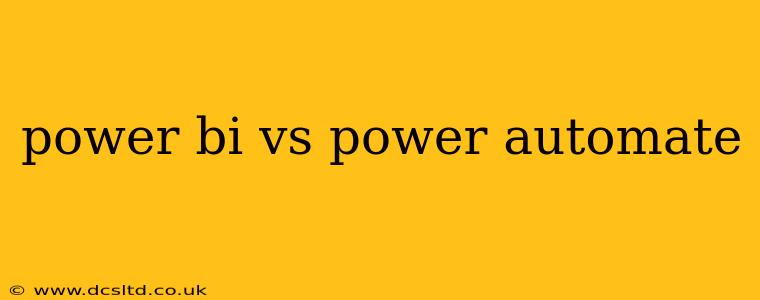Microsoft Power BI and Power Automate are both powerful tools within the Microsoft Power Platform, but they serve distinct purposes. Understanding their differences is crucial for leveraging their combined potential effectively. This article will delve into the core functionalities of each, compare their strengths and weaknesses, and explore how they work together to streamline business processes and enhance data-driven decision-making.
What is Power BI?
Power BI is a business analytics service that provides interactive visualizations and business intelligence capabilities. It's designed to connect to various data sources, transform that data, and then present it in easily digestible charts, graphs, and reports. Think of it as your data storytelling platform. Its strength lies in its ability to transform raw data into actionable insights.
Key Features of Power BI:
- Data Connection & Transformation: Connects to a multitude of data sources (databases, spreadsheets, cloud services, etc.) and allows for data cleaning and transformation within the platform.
- Interactive Visualizations: Creates stunning and interactive dashboards and reports with a wide array of chart types, allowing for dynamic exploration of data.
- Data Storytelling: Facilitates the creation of compelling narratives around data, making complex information accessible to a wider audience.
- Collaboration & Sharing: Enables easy sharing of reports and dashboards with colleagues, fostering collaboration and data-driven decision making.
- AI-powered insights: Offers features like Quick Insights and AI-driven visual suggestions to help users uncover hidden trends and patterns.
What is Power Automate?
Power Automate (formerly Microsoft Flow) is a cloud-based workflow automation service. It allows users to create automated workflows, also known as "flows," that connect different applications and services. These flows automate repetitive tasks, integrate different systems, and improve efficiency. It's all about streamlining processes and reducing manual work.
Key Features of Power Automate:
- Workflow Automation: Automates repetitive tasks across various applications and services, saving time and reducing errors.
- Integration with various apps: Connects to a vast ecosystem of applications, including Microsoft 365, Salesforce, Google Workspace, and many more.
- Triggers and Actions: Uses triggers (events that initiate a flow) and actions (tasks performed within a flow) to build automated processes.
- Approvals and Notifications: Integrates approval workflows and notifications to keep stakeholders informed and ensure accountability.
- Scheduled Flows: Allows for the automation of tasks based on scheduled times, ensuring regular execution of processes.
Power BI vs. Power Automate: A Head-to-Head Comparison
| Feature | Power BI | Power Automate |
|---|---|---|
| Primary Function | Data visualization and Business Intelligence | Workflow automation and process integration |
| Output | Interactive reports, dashboards, visualizations | Automated tasks, updated data, notifications |
| Data Focus | Analysis and interpretation of data | Movement and processing of data |
| User Skills | Data analysis, visualization skills | Workflow design, understanding of logic |
| Typical Use Case | Analyzing sales figures, tracking KPIs, generating business reports | Automating invoice processing, sending email alerts, updating CRM records |
How Power BI and Power Automate Work Together
While distinct, Power BI and Power Automate are incredibly powerful when used together. Power Automate can feed data into Power BI, automating the data refresh process and ensuring that your reports are always up-to-date. This combination allows for a truly dynamic business intelligence solution.
For example:
- Automated Report Generation: Power Automate could collect daily sales data from your CRM, process it, and automatically update a Power BI dashboard, eliminating the need for manual data entry and report generation.
- Triggered Notifications: A Power Automate flow could monitor key metrics in a Power BI dashboard. If a critical threshold is breached (e.g., sales drop below a certain level), it could automatically send email alerts to the relevant team members.
- Data Consolidation: Power Automate can gather data from multiple disparate sources and consolidate it into a single, unified dataset which is then easily imported into Power BI for analysis.
Frequently Asked Questions
Which is better for beginners, Power BI or Power Automate?
Both platforms offer beginner-friendly interfaces, but Power BI might be slightly easier to grasp initially due to its more visual nature. Power Automate requires a more logical approach to designing workflows.
Can I use Power BI without Power Automate?
Absolutely! Power BI functions perfectly well independently, allowing you to connect to data sources and create reports without any automation.
Can I use Power Automate without Power BI?
Yes, Power Automate can be used completely independently to automate various tasks and processes without any interaction with Power BI.
What are the licensing costs for Power BI and Power Automate?
Licensing costs vary depending on the specific features and user needs. Microsoft offers various licensing plans for both Power BI and Power Automate, including free versions with limitations. Check Microsoft's official pricing page for the most up-to-date information.
In conclusion, while Power BI and Power Automate serve distinct purposes, their synergistic capabilities create a powerful combination for driving efficiency, improving decision-making, and fostering a data-driven culture within organizations. Understanding their individual strengths and how they work together is key to unlocking their full potential.
